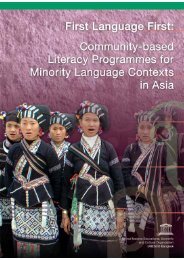Part II.pdf - MTB-MLE Network
Part II.pdf - MTB-MLE Network
Part II.pdf - MTB-MLE Network
You also want an ePaper? Increase the reach of your titles
YUMPU automatically turns print PDFs into web optimized ePapers that Google loves.
2002 statistics from the Ministry of Education indicated the percentage of students in formal schooling<br />
and the target of non-formal education as follows:<br />
Percentage<br />
Age Level of Education Formal Non-formal<br />
schooling education<br />
3-5 yrs Pre-school children 69.94 30.06<br />
6-11 yrs Primary education 104.77 –<br />
12-14 yrs Lower secondary 82.23 17.77<br />
15-17 yrs Upper secondary 59.82 40.18<br />
18-22 yrs Higher education 43.82 56.18<br />
22 yrs up – – 100.00<br />
The EFA plan focusing on NFE and literacy in the country is operated under a limited budget. In<br />
the 1998 fiscal year, for example, the education budget for Thailand was set at 23.1% of the country’s<br />
total budget, or about 4% of GDP. This demonstrated the commitment of the Thai Government<br />
towards providing education for the people of Thailand. However, from this funding, the adult<br />
and non-formal education received only 1.19% of the country’s budget.<br />
In 2004 fiscal year, the budget was allocated for education as follow:<br />
Total budget for education = 190,262,836,200 Baht (100%)<br />
Office of Non-formal Education = 3,795,241,900 Baht (1.9%)<br />
Office of Basic Education Commission = 124,288,877,200 Baht (65.3%)<br />
Office of Higher Education = 40,006,029,800 Baht (21.0%)<br />
These figures show a distinct bias in funding educational programmes for out-of school people. It<br />
was thought that many adult learners worked and gained income, which should therefore allow<br />
them to pay for their own further education. This ignored the fact that often the money earned<br />
from jobs was barely enough for day-to-day survival of the workers and their families. With<br />
a limited budget, it was difficult for the non-formal education organizations to effectively reach<br />
those unable to afford or have easy access to further education opportunities. Furthermore, 69%<br />
of the budget allocated to education was set for staff salaries, and the rest was then used for investment<br />
and development of equipment, land and construction.<br />
3. Policy on Mother Tongue/bilingual Education in the<br />
Country<br />
In Thailand, ONFEC was assigned to run literacy programmes in order to promote Thai people<br />
to read and write Thai language which is the national language. At present, this policy is<br />
continuing and implemented in all target population groups. This reflects the long-standing “cultural<br />
unity” policy of the country. However, there is a trend to focus on the mother tongue for the following<br />
reasons:<br />
199
















